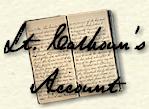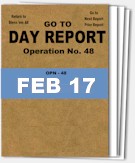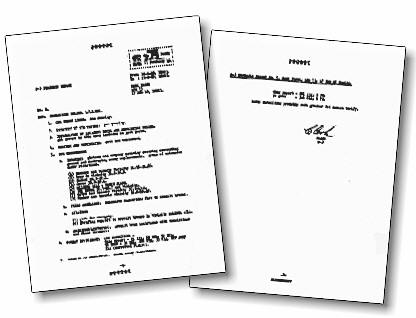|
Now
"F" Company was
desperately short on
officers. In one morning we
had lost three,
and one had been lost on the
jump. Only the company
commander, Bill Bailey, and
the 1st platoon
leader, Bill Calhoun, were left. The
2nd platoon had lost their
platoon
leader, their platoon
sergeant and the sergeant
who had replaced their
platoon sergeant. At this time the first platoon was still missing the six men who had
returned in plane
number 22 to Mindoro. They
were coming by water with
the 1st Battalion. These men
were all in the 1st squad
which had lost Handlon and
Thomas the first day.
T/Sgt Joseph Shropshire
withdrew the 3rd platoon
without orders.
Bill Bailey
was not
at all happy. He told me to
take the 3rd platoon back
out there, put them in
position
to attack and await orders.
We moved back out to the
berm and the RDF shelter hill. I
think we would all have been
in better spirits had we not
been so thirsty. Anyhow we
waited and sweated.
During the afternoon
we noticed smoke coming
from the interior of the
battery.
The way the Japs seemed to come and go we did not know how heavily the
battery would be defended.
Sometime they were there and
some time they were not. If
they were ready and
waiting it could be a bloody
affair. Then there was the
thought that with the Japs
being able to come in
through tunnels, if you took
the battery would you really
have it?
About
1500 hour word came that 1st
Lt. James Gifford was coming
out with his first platoon, D Company to make the assault. They got there
about 1530.
Jim made his reconnaissance,
and we withdrew so that the
artillery could lay down a
barrage
on Wheeler. The assault was
to be made immediately after
the barrage lifted. The attackers would have to
crawl to the top of the berm
about
thirty feet wide, dash
down the steep incline about
twenty feet into the road
behind Wheeler, run about
thirty
feet crossing the railroad
to the battery, climb the
stairs to the floor of the
gun port,
cross this floor and mount
the stairs leading up to the
top of the parapet. They
would
have their choice of stairs.
One set was at the left side
of the gun port, the other
at the right side. These stairs would put them on top of the parapet with
the Japs
still in the battery
beneath. This problem would
resolve itself that night.
As the time for the assault
drew near I really sweated
it out for Jim Gifford, his
assistant platoon leader,
Jack Mara, and their men.
The attack was carried out
in a
splendid fashion. They threw
smoke grenades and the
entire platoon rushed
forward as one solid body and stormed to the parapet. In the 503rd
when
the command to go was given
we
stood up and went with no
laggards. Gif and his men
demonstrated this mark of an
elite
unit
brilliantly. Pucci, Combs,
Hess, Verdell, and Mayberry
were wounded during the
assault.
By about 1730 we had
finished our digging in at
the AA position. 1st
Lt. Daniel A.
Lee, a recent replacement
who had been assigned to
Headquarters Company, 2nd
Battalion,
came out there and set up a
50 caliber machine gun. (I
have no idea where he got
it.) I had a light
machine gun section attached
to my platoon. Of course my defensive position
covered 360 degrees, but we
were particularly
concerned-about the portion
of the deep ravine which jutted to the west between our position and the Senior
Officers Row.
We had to circle this ravine
to get to our company CP at
28-D. In this portion of the
defense we occupied the
ditch along the side of
Crockett Trail which ran
along the rim
of the drop-off into the
ravine before it began its
descent into the ravine
through a series of
switch backs.
Night came suddenly as it
does so dramatically in the
tropics. Our last water had
been what we jumped with in
our two canteens thirty
hours ago. Of course our
rations were long gone, too; however Kipling
put it so fittingly:
" But when it comes to
slaughter
You will do your work on
water,
An' you'll lick the bloomin'
boots of 'em that's got it."
As the darkness turned
pitch, the wind seemed to
rise, rattling the metal
debris. There
had been buildings here
before the Japanese invasion
and an abundance of wreckage
was
strewn about, especially
pieces of corrugated metal
roofing. Some hand grenade
throwing
went on. The machine guns
fired a lot.
When the naval star shells
burst overhead and
illuminated the area I would
rise up and look good, but I
never saw anything
suspicious
About the time things began
to quieten down, around 2200
hour, the ground started
shaking
a strange grating sound
began along with a loud
noise of sucking air much
like the sound made if one purses their lips and draws air in quickly, and suddenly with
a roar flames
gushed out of Battery
Wheeler's back side and shot
skyward for maybe one
hundred feet or
more.
I wondered what was
happening to Gif and Jack
and their men. I felt like
they probably ran when the noise started. The fire lasted for about five
minutes illuminating
the entire area like day. We
could see nothing moving
anywhere.
About fifteen minutes
later the battery erupted in
flames again, but the
duration of the fire was
shorter this time. During the eruptions we could feel the heat. The men on the
right flank
of our defense who were near
the battery moved back a
distance until the fireworks
were
over.
After the flames ceased we
could hear sizzling and
popping sounds coming from
within
the battery. We knew this
was the bodies of the Japs
inside burning. After
darkness returned it seemed
unusually quiet. It had been
a long and harrowing day.
I was dead tired. I thought
I would rest a few moments
until another star shell
illuminated the area.
After what seemed only
moments I awoke with the sun
shining brightly in my face.
It was already getting warm.
This was one of those times
when it took a short time to
locate myself. For an
instant I was back on
Mindoro where we were
building a fortified line.
As realization of my
location dawned on me, I
reflected for a few seconds
on how safe we had been at
that time. Our only worry
there was the Japanese
planes with their bombs and
machine guns.
Well what the hell, I told
myself. You wanted combat,
now you have it.
|




